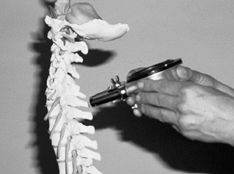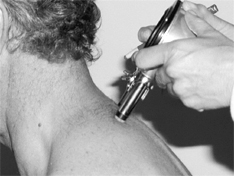Instrumentation: Cervicothoracic Junction
A difficult area to analyze with a NervoScope (or Delta-T, Go-Scope, etc) is the cervicothoracic junction. I recall seeing a video of Dr. Gonstead correcting a doctor who wasn’t tilting the NervoScope properly over that region.
It is important to maintain the instrument perpendicular to the spine (as seen from the side). It is not uncommon for the plane line of the C7 disc to be angled quite acutely from horizontal. With the patient in the sitting position, and if the patient is hunched over slightly, the angle is often 60° or near vertical. The angle diminishes as the instrument runs cephalically and reduces rapidly when gliding over “the hump” and into the upper thoracic spine. It is common to see those new to the instrument glide the instrument at less than a 45° angle at the C7 and C6 levels. Usually, they miss breaks at those levels, because, in many cases, the sensors wires completely miss the C6-C7 region and often aren’t even touching the skin.
Use a dry model with the correct curves and compare the tilt of your instrument to the spine, in particular, the C7 disc. You will quickly discover that to keep the instrument parallel to the C7 disc line, a substantial acute angle to the horizon is required. Stand at the side of a patient and visualize the angle that the C7 disc plane line is to the horizon. Place your instrument at C7 and angle it until it is parallel to the visualized C7 disc plane line. Practice gliding the instrument from T3 to C5 and vice versa while being cognizant of the degree of tilt of the instrument at each level. Practice that a thousand times until it becomes automatic. You will find that you will pick up cervicothoracic breaks that you were missing.
PHOTO 1: Dry spine: notice the angle of C7 and the NervoScope.
PHOTO 2: Notice how the doctor has to angle the NervoScope.


